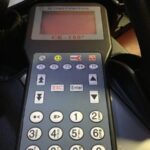Experiencing engine trouble with your Ford? Diagnostic Trouble Code (DTC) P0352, specifically “Ignition Coil B Primary/Secondary Circuit Malfunction,” can point to issues within your Ford’s ignition system, particularly affecting Cylinder 2. This code, while generic to OBD-II systems, is crucial to address promptly in Ford vehicles to prevent further engine damage and maintain optimal performance. Code P0352 can trigger your check engine light (CEL), lead to engine misfires, and diminish your Ford’s power and fuel efficiency. While a failing ignition coil is often the culprit, other electrical and mechanical problems can also lead to this code in your Ford.
This guide, tailored for Ford owners and enthusiasts, explains the intricacies of DTC P0352, its common causes in Ford vehicles, diagnostic procedures, and effective solutions. Remember, while this information is comprehensive, it’s always recommended to consult your specific Ford model’s repair manual or a trusted mechanic for the most accurate and vehicle-specific guidance. For access to a vast database of confirmed fixes for codes like P0352 across various Ford models, resources like Identifix Direct-Hit can be invaluable.
Decoding Ford Code P0352: Ignition Coil ‘B’ Explained
The OBD-II code P0352 signals a malfunction within the “B” ignition coil circuit, specifically related to Cylinder 2 in your Ford engine. Let’s break down what each part of the code signifies:
- P (Powertrain): This indicates the issue is within the powertrain system, encompassing the engine, transmission, and related components.
- 0 (Generic Code): The “0” signifies that this is a generic OBD-II code, meaning it applies to all makes and models, including Ford, that utilize the OBD-II system.
- 3 (Ignition System): The “3” points to the ignition system as the area where the fault lies.
- 52 (Cylinder 2 & Coil ‘B’): The “52” pinpoints the problem to Cylinder 2 and specifically designates “Ignition Coil B.” In many Ford engines, the ignition coils are sequentially labeled, and in this context, ‘B’ directly corresponds to the coil for Cylinder 2.
When your Ford’s Engine Control Module (ECM) detects irregularities in the electrical circuit of the ignition coil for Cylinder 2, it triggers the P0352 code. This disruption can manifest in several noticeable symptoms in your Ford:
- Check Engine Light (CEL) Illumination: The most immediate sign is the illumination of your CEL on the dashboard.
- Engine Misfires: You may experience rough idling, hesitation during acceleration, or a noticeable lack of power, indicating engine misfires, especially in Cylinder 2.
- Powertrain Vibrations: Misfires can cause vibrations felt throughout the vehicle, particularly at idle and during low-speed driving.
- Reduced Engine Power and Fuel Economy: Inefficient combustion due to misfires leads to decreased engine performance and lower gas mileage in your Ford.
Ignoring a P0352 code in your Ford can lead to more serious issues. Prolonged misfires can damage catalytic converters, wear down spark plugs and ignition coils prematurely, and even cause piston ring damage in the long run. Addressing the root cause of P0352 promptly is crucial for maintaining the health and longevity of your Ford’s engine.
Common Causes of Ford P0352 Error Code
To effectively diagnose and fix the P0352 code in your Ford, understanding the potential culprits is essential. This code indicates a communication breakdown between your Ford’s ECM and the ignition coil for Cylinder 2. Let’s delve into the relationship between these components and explore the common causes:
In a typical Ford ignition system, the battery provides low-voltage power to the ignition coil. The coil then transforms this low voltage into high voltage necessary to create a spark at the spark plug. This process involves the primary and secondary windings within the coil. The ECM meticulously monitors this process, ensuring precise cylinder firing timing for optimal engine operation. When deviations occur in this sequence for Cylinder 2, the P0352 code is triggered.
Here are the common causes of Ford DTC P0352:
- Faulty Ignition Coil (Cylinder 2): The most frequent cause is a defective ignition coil itself. Coils can fail due to age, heat stress, or electrical overload. Testing the resistance of the coil is a key diagnostic step.
- Defective Spark Plug (Cylinder 2): A worn, fouled, or damaged spark plug in Cylinder 2 can put excessive strain on the ignition coil, or cause misfires that trigger the code. Inspecting the spark plug condition is crucial.
- Wiring Issues to Ignition Coil (Cylinder 2): Damaged, corroded, or frayed wiring leading to the Cylinder 2 ignition coil can disrupt the electrical circuit. This includes the wiring harness, connectors, and individual wires. Ford vehicles, especially older models, can be prone to wiring degradation.
- Loose or Corroded Connectors: Loose or corroded electrical connectors at the ignition coil or ECM can interrupt the circuit. Inspect and clean connectors thoroughly.
- Less Common Causes:
- Idle Air Control (IAC) Valve Issues: While less direct, a malfunctioning IAC valve can sometimes cause engine irregularities that indirectly trigger misfire codes, though this is less likely to directly cause P0352.
- Carbon Buildup in Throttle Body: Excessive carbon buildup can affect airflow and potentially contribute to misfires, but again, less directly linked to P0352.
- ECM Malfunction (Rare): In rare cases, a faulty ECM might misinterpret signals or incorrectly trigger the P0352 code. This is usually diagnosed after ruling out other causes.
Accurate diagnosis is paramount when dealing with P0352 in your Ford. It’s important to systematically rule out each potential cause to avoid misdiagnosis and ensure effective repair. Misdiagnosis can lead to unnecessary parts replacements and prolonged troubleshooting.
Step-by-Step Diagnostics for Ford P0352 Code
Diagnosing the P0352 code on your Ford requires a methodical approach to pinpoint the root cause. While it might be tempting to immediately replace the ignition coil, a thorough diagnostic process is crucial to avoid misdiagnosis and ensure a lasting fix. Vacuum leaks and, less commonly, a faulty ECM can sometimes mimic symptoms of ignition coil issues, leading to incorrect diagnoses.
Follow these steps to effectively diagnose the P0352 code on your Ford:
-
OBD-II Scanner Code Verification: Use an OBD-II scanner to confirm the presence of the P0352 code and check for any other related codes. Record all codes present, as they can provide valuable clues.
-
Inspect Cylinder 2 Spark Plug:
- Locate Cylinder 2 in your Ford engine (refer to your vehicle’s repair manual if needed).
- Carefully remove the spark plug for Cylinder 2.
- Inspect the spark plug condition: Look for signs of wear, damage, fouling (carbon buildup, oil), or cracks.
- Compare the Cylinder 2 spark plug to others if possible to identify anomalies.
- A severely worn or damaged spark plug should be replaced.
-
Test Ignition Coil Resistance (Cylinder 2):
- Disconnect the electrical connector from the Cylinder 2 ignition coil.
- Use a multimeter set to measure resistance (Ohms).
- Test the resistance of the ignition coil according to your Ford repair manual’s specifications. Compare the reading to the specified range.
- An out-of-specification reading indicates a faulty ignition coil that likely needs replacement.
-
Inspect Ignition Coil Wiring and Connectors:
- Visually inspect the wiring harness and connectors leading to the Cylinder 2 ignition coil and back towards the ECM.
- Look for:
- Fraying, cracking, or damage to the wire insulation.
- Corrosion or damage to the electrical connectors.
- Loose or broken wires.
- Signs of melting or heat damage near the exhaust manifold or engine block.
- Gently tug on wires to check for looseness or breaks.
- Clean corroded connectors with electrical contact cleaner. Repair or replace damaged wiring or connectors as needed.
-
Check Ignition Coil Ground Supply:
- Locate the ground wire for the ignition coil circuit (refer to wiring diagrams).
- Use a multimeter to check for proper ground continuity.
- Ensure the ground connection is secure and free of corrosion.
-
Measure Signal Between ECM and Ignition Coil:
- This step may require a more advanced multimeter or oscilloscope and is often best performed by a professional technician.
- With the ignition on (engine off), check for the presence of a signal from the ECM to the ignition coil trigger wire using a multimeter or logic probe.
- Absence of a signal might indicate an ECM issue or a wiring fault in the signal circuit.
Pro Tip: Having a spare spark plug and ignition coil on hand during diagnostics can be beneficial. Swapping components can help quickly isolate the issue. For example, swap the Cylinder 2 ignition coil with the coil from a different cylinder (e.g., Cylinder 1). Clear the codes and see if the code moves to P0351 (Cylinder 1). If it does, the coil is likely faulty.
If you are uncomfortable working with electrical systems or lack the necessary tools, it is always advisable to take your Ford to a certified mechanic or Ford dealership for diagnosis and repair.
Resolving Ford P0352 Code: Repair Solutions
The specific repair for Ford DTC P0352 hinges directly on the diagnosis. Once you’ve pinpointed the faulty component, the repair process generally involves replacement or repair of the damaged part.
Here are common solutions for resolving Ford P0352 code, based on potential causes:
-
Replace Faulty Ignition Coil (Cylinder 2): If the ignition coil resistance test fails or swapping coils shifts the code, replacing the ignition coil for Cylinder 2 is the likely solution. Use a quality replacement ignition coil, preferably OEM Ford or a reputable aftermarket brand.
-
Replace Defective Spark Plug (Cylinder 2): If the spark plug is worn, damaged, or fouled, replace it with the correct type spark plug for your Ford model. Consider replacing all spark plugs if they are due for maintenance.
-
Repair or Replace Damaged Wiring or Connectors: If wiring inspection reveals damage, corrosion, or broken connectors, repair or replace these components. Use proper wiring repair techniques and ensure secure, weather-tight connections. Wiring harness sections may need replacement in cases of extensive damage.
-
Address Ground Circuit Issues: Ensure a clean and secure ground connection for the ignition coil circuit. Clean any corrosion and tighten ground bolts or screws.
-
ECM Replacement (Rare): If all other components are ruled out and ECM malfunction is suspected (usually after professional diagnosis), ECM replacement or reprogramming might be necessary. This is a less common solution and often requires dealer intervention.
-
Vacuum Leak Repair (If Misdiagnosis): If a vacuum leak was initially suspected and found to be the cause of misfire-like symptoms, repair the vacuum leak (replace hoses, gaskets, etc.). However, vacuum leaks are less likely to directly trigger a P0352 code.
Post-Repair Steps:
-
Clear DTC Codes: After completing the repair, use an OBD-II scanner to clear the P0352 code and any other related codes from the ECM memory.
-
Test Drive: Perform a test drive to verify that the engine misfire is resolved and the check engine light remains off. Monitor for any recurrence of the code or symptoms.
-
Re-scan for Codes: After the test drive, re-scan the OBD-II system to ensure no codes have returned.
For complex or persistent P0352 issues in your Ford, especially if you are unsure about electrical diagnostics or repairs, seeking assistance from a qualified mechanic or Ford technician is always the best course of action. Utilizing resources like Identifix Direct-Hit can provide access to Ford-specific repair information and confirmed fixes, potentially streamlining the repair process and ensuring a successful outcome.

